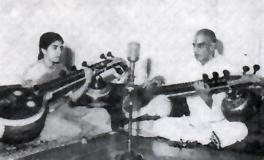THE RANGARAMANUJA AYYANGAR SAGA - PART 5
- By Padma Varadan
Father was a stickler for discipline, be it in day-to-day routine chores or in more enduring commitments in life. His commitment to Vina topped them all where his students were involved. For instance, it was totally irrelevant that I was the sole survivor among eight children. I remember when I was seven years old, some extraneous pressures at school had thrown me out of gear and I missed out on Vina practice a little too often. Father chucked my Vina into the attic, tore my music notebook into shreds and vowed never to teach me formally. It took months of persuasion before the Vina could be brought down and I could resume my association with it. But he stood his ground for many years to come insofar as my formal training in music was concerned. Nor did he relent on not writing music for me thereafter!

Rangaramanuja Ayyangar with daughter Padma
Varadan
RRA's last days
Daily readings from Valmiki's Ramayana for nearly 60 years of Father's life yielded a synthesis of the three main streams of the epic which he left behind as a manuscript. He had another work on Silappadikaram on the anvil, but he did not live to accomplish it. In fact, he was full of regret that he fell short of his goals just to that extent and it was foremost in his psyche minutes before he lapsed into coma on 20th May, 1980.
The colossus - he was that to me and many others - is physically no more with us. But he lives on in a hundred myriad ways through every page of his monumental publications and his other published pieces - in his abiding faith that the Carnatic music tradition will continue as the eternal spring of sustenance for other music systems. In the sagas of untiring crusade for value based music involvement. In that lone voice that time and again sought to expose hollowness, sham and shibboleths masquerading under high sounding lables of guru-sishya paramparas. In his impatience with the glorification of the oral tradition in the learning process, especially after he had to wade through any number of renderings to arrive where he ultimately did. In his rigid stand that obsolete teaching methods deserved to be replaced with more rational emphasis of the utiltiy of simple classical compositions to give even the beginner a sure sense and feel of melody and rhythm, let alone sustaining the student's interest. In his outbursts of despair over the stereotyped, staid concert pattern which had become a pot-pourri of torrential, boxing bouts between the main instsrument and their obliging percussionists. Whereas there was urgent need to revamp the concert pattern, to ensure a leisurely independent treatment of one aspect for Carnatic music at a time, reorientation of the audience to look forward to several such sittings, was, he conceded, an even more challenging task.
- 1934 - Papanasam Sivan's Keertanamalai, Part 1: 100 songs notated in detail with notes on Raga lakshana as rendered by Sivan himself.
- 1941 - Purandaramanimalai, Part 1: 100 Purandaradasa's padams notated and published for the first time on behalf of the redoubted duo Lalitangi and her daugther, M L Vasantakumari.
- 1947 - Kritimanimalai, Part 1: Launched at a function in Madras with 100 kritis of Tyagaraja with detailed notation, biography and annotations to coincide with Tyagaraja's birth centenary.
- 1948-1950 - Kritimanimalai, Parts 2 and 3: Released in similar format to include more compositions of Tyagaraja and in addition, Part 4 with select compositions of Muthuswami Dikshitar, Syama Sastri and Kshetragna padams.
- 1952-1954 - Kritimanimalai, Parts 5 and 6: Published to include more of Muthuswami Dikshitar's kritis and Syama Sastri and other post-Tyagaraja period composers including some Tamil Padams, Tillanas and Javalis respectively.
- 1962: Composing tunes for, editing and publishing Harikeertans of Swami Suddhananda Bharati.
- 1962 - Kritimanimalai, Parts 1 to 4, Tamil, over 3000pp, hardback: Magnum opus revised, enlarged and regrouped into four huge volumes comprising 1500 compositions in all of the Trinity and miscellaneous composers.
For further details about the publications, contact: Vipanchi Cultural Trust, 20, Kasturi Buildings, J Tata Road, Churchgate, Mumbai 400 020. Telephone: 022 283 3041
The RRA Saga - Part 3
The RRA Saga - Part 2
The RRA Saga - Part 1